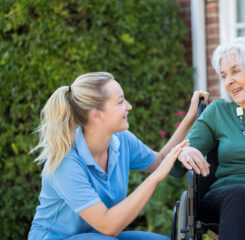Home Health Member Network – August 2022
CMS Listening Session
CMS staff opened the conversation with their gratitude to hear from providers on this important rule and shared their goal of collaborating with the community.
LeadingAge member home health agencies provided feedback on several critical topics in the CY2023 Home Health Proposed Rule.
Lisa Steiner, CEO of Clarion Forest VNA shared that her agency served a very rural area in Pennsylvania with limited cell towers and little to no internet access. She promised her staff when PDGM was implemented there would be no therapy layoffs and she has been able to keep her word. They did not shift their therapy utilization based on payment changes and did not over utilize therapy under the previous payment system. She shared that her agency also did not change coding and documentation practices and had always identified patient need based on the assessment process. Clarion Forest VNA was also facing, like many other home health providers, staffing issues requiring them to increase their wages to stay competitive. She also noted that the phasing out of the rural add on for home health would be another detrimental impact to her agency. The rule as proposed now, would dismantle rural home health agencies like Clarion Forest VNA.
Ruth Martynowicz, Executive Vice President of Operations for Trinity Health at Home shared that her agency covered almost the entire nation and has both rural and urban locations. She shared the behavioral assumptions felt insulting after nearly three years of home health agencies breaking their backs to see patients at home during the COVID pandemic. All of Trinity Health at Home’s staff were certified in coding and OASIS so the work was done accurately. Ruth shared it was difficult to provide educated comments on CMS’ behavioral assumptions around LUPAs or coding changes without published data from CMS to review. She echoed Lisa’s concerns about recuriting staff especially when their competition includes places like Amazon. She noted that for FY 2022 their nationwide agency broke even and that would not be the case if changes proposed in this rule went forward.
Barb Samson, National Director of Quality and Clinical Services at Trinity Health at Home echoed her colleagues concerns and shared they have worked to find efficiencies in their process while providing high quality care to communities across the country. She shared they work to take all patients and not turn any away. She shared concerns about the proposal to require OASIS collection on all patients regardless of payer and how it would impact the time clinicans had to see patients. The proposal feels like an unfunded mandate as there is no assurance that commercial payers would support the additional cost of collecting OASIS on their covered populations.
Carlin Brickner, Vice President of Data Sciences for VNS Health based out of New York City shared concerns regarding CMS’ methodology for determining the therapy services behavioral assumptions. CMS’s methodology to determine provider behavior adjustments for budget neutrality in the proposed rule compares PDGM in 2020 and 2021 to what would have happened if PDGM were not implemented, and the 4 equation PPS payment model (4EQ) were continued. The goal is that CMS can observe PDGM behavior changes, and compare to payments that would have been made to the same patients grouped under 4EQ PPS. However, Carlin this comparison assumes that there is just one policy that providers may respond to with behavior changes – that is, PDGM – when in fact there are two: PDGM and 4EQ PPS. Providers see the this drop in therapy utilization is a confirmation that CMS was successful in eliminating therapy thresholds and creating a true prospective payment model in PDGM as required by the 2018 balanced budget act. However, CMS is now turning to use this reduction in therapy thresholds to penalize providers for reducing therapy visits. Carlin laid out several alternative methodologies CMS could use to develop a more realistic view of therapy changes.
Kerri Mai, Assistant Director of Home Health for Goodwin House based in Northern Virginia shared her agencies concerns as a multi-service line provider. Goodwin House has 130 to 150 independent living residents on their campus which includes home health, hospice, and skilled nursing services. She cautioned that this rule would create a domino effect in their community. They often are selective in the numbers of cases they take due to continued staffing issues and a commitment to serve their campus. Not having additional funds to support individuals needing support in staying in independent living will impact staffing since they are already struggling to pay higher wages in their area. She also shared the patient population her agency serves is seeing an increase in illness and hospitalizations. It’s a cycle her agency has been trying to break but inevitably the population is sicker than before the pandemic. She clearly articulated that if CMS attempted an aggregate recoupment of the proposed $2 billion in temporary retrospective adjustments, her agency could not sustain their work in the community they serve.
Dorothy Davis, President and CEO of Visiting Nurse Health System in Atlanta, GA shared her gratitude with CMS for the chance to be heard. Of her agency’s 800 patients on service. 75% came from Grady Health System, the safety net hospital in Atlanta. If implemented, this rule would be devestating to her patient population on many levels. She finds that her agency’s collaboration with Grady is unique and that many for-profit agencies in her area do not have equally as Hierarchical Condition Categories scores. She fears that if this rule went into effect, fewer patients with these higher acuity scores would be seen by other agencies. She stressed that as CMS continues to shift payments to focus on value scores like HCC and star ratings should take into consideration the acuity and health disparities of different patient populations. Dorothy’s agency sees these disparities play out on a daily basis.
Several other members of LeadingAge echoed the concerned raised by the speakers on the call. One member shared that a recent statistic found 51.5% of home health agencies would be looking at operating costs that exceeded revenue, meaning many would go out of business or have to drastically reduce services. Another member shared concerns about the impact to acute care institutions like hospitals or nursing homes. With capacity decreasing due to staffing shortages, an additional hit from these proposed cuts would mean fewer admissions to home health leading to more patients staying in hospitals longer due to not having a safe discharge plan.
CMS responded to the feedback from members with appreciation. The boots on the ground perspective are invaluable to their work and they take the formal comment process very seriously. CMS staff urged members to submit comments sooner than later, especially if they contained technical information, to give CMS time to evaluate all potential directions for the rule. They stressed that the goal was not simply to cut rates but to follow the law and get it right by further perfecting their methodologies and adjustments. They felt rule making, and conversations like these, are a two-way street and stress again how important comments where to their decision-making process. They were prepared to do due diligence on all comments and follow every rabbit hole. They recognized that in order to serve Medicare beneficiaries they must have providers and the importance of finding the middle road with that community. Additionally, they encouraged LeadingAge and its members to work with Congress on policy changes which CMS did not have the authority to change such as the rural add on for home health which is expiring.
LeadingAge Advocacy Efforts and Member Action
LeadingAge staff reiterated CMS urge for members to submit comments. A webpage was created for LeadingAge home health members to access information about the rule including a toolkit to help develop their own agency specific comments. Additionally, an action alert was released earlier in the week providing staff, board members, and community partners a quick and easy tool to submit comments on the proposed rule. Finally, legislation was introduced in Congress that would delay the proposed cuts until 2026. Members were urged to reach out to their members of Congress and ask for their support and co-sponsorship of the legislation.

Most Recommended
November 08, 2024
 HOTMA: New Rules for Housing
HOTMA: New Rules for Housing
November 06, 2024
 Colleagues on the Move, November 6, 2024
Colleagues on the Move, November 6, 2024
November 06, 2024
 Analysis: What Does the Final CY2025 Home Health Rule Include?
Analysis: What Does the Final CY2025 Home Health Rule Include?
October 29, 2024
Katie Smith Sloan Urges Members to Build a Movement, Take Action
Recently Added
December 10, 2024
4 Top Tech Themes from 2024
December 09, 2024
 Analysis: What’s Changing with the Home Health CAHPS Survey?
Analysis: What’s Changing with the Home Health CAHPS Survey?
December 09, 2024



